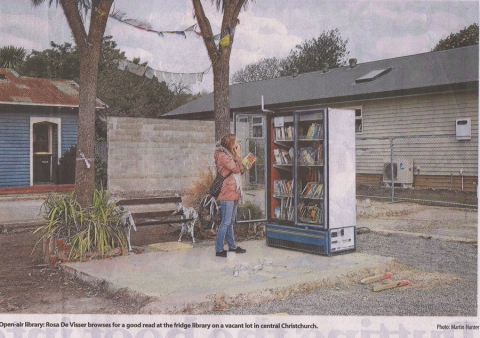Archival Data Loss Threats
From booktorrent
Smallest City Library?
"Some small and remote villages have tiny libraries, tucked in a cupboard of the local church or post office. But this might be the smallest library in a city.
The city is Christchurch New Zealand, ravaged by earthquakes in November and February, and where most of the city libraries are closed.
The library is a glass fronted fridge functioning as a book exchange. It sits on a cleared street corner, and anyone can go along with a book and swap it for another. The fridge is the latest in a series of temporary projects run by a couple of trusts: Gap Filler and Greening the Rubble. Their aim is to restore a bit of life and vitality to some of the empty spaces left by the earthquakes.
The chance is there to experiment – try out a lot of small projects with the expectation that some will fail, but that there will be some successful ideas come through".
Photo Credit: William Flew Just another WordPress.com site[1]
Damage to documents leads to the implementation of restoration and copying programs however, no reconstructed set of data will ever equal original data, either in completeness, context, legal or cultural value, or for the purpose of the accountability of the record-creating bodies.
Some common reasons for losing data are:
- Data stored in non-preservation file formats, i.e. proprietary file formats that are no longer commonly used;
- Large amounts of digitized and “digital-born” data stored locally, on internal servers and internal hard drives;
- Lack of resources to migrate large amounts of digital data to a curation facility/repository capable of adequately storing these data.
- Computer disks and other magnetic and optical media degrade, and the information on them is lost unless it has been moved to other media.
- Software and hardware change rapidly: the physical media on which digital data are stored are impermanent.
- Natural disasters such as floods, earthquakes, or tornadoes.
- Man made disasters such as war, vandalizm, or failure to prevent fire hazards within any storage dwelling.
- Improper restoration methods causing materials to deteriorate more.
- Improper handling of physical materials during the prossessing stage.
- Damaging materials when allowing others to view or research archival stock.
Other methods are necessary to ensure wide access to and long-term preservation of digital data.

